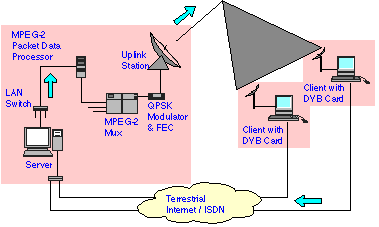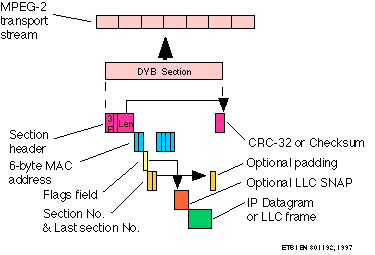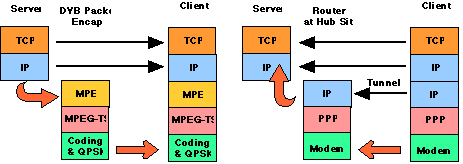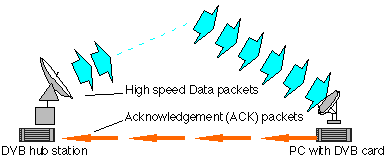
The growing use of multimedia-capable personnel computers to access the Internet and in particular, the use of world wide web, has resulted in a growing demand for Internet bandwidth. The emphasis has moved from basic Internet access to the expectation that connectivity may be provided whatever the location. This presents fresh challenges to the networking community, particularly as users become familiar with the benefits of high speed connectivity.
Along with an increased use of the Internet, there has also been a revolution in television transmission, with the emergence of Digital Video Broadcast (DVB) .The same system may support a high speed Internet, and is being supported on a number of DVB satellite systems. A high speed (6-34 Mbps) simplex data transmission system may be built using a digital Low Noise Block (LNB) and standard TV antenna connected via an L-band co-axial cable to a satellite data receiver card in a PC (or LAN adaptor box). In many cases, a return link may be established using the available (standard dail-up modem) terrestrial infrastructure, providing the full-duplex communication required for the Internet service. Low-cost satellite return channels are also available. The overall system may provide low cost, high bandwidth, Internet access to any location within the down-link coverage of a the DVB satellite service.
Data is already being sent over DVB networks using the MPEG-2 transport stream. A variety of proprietary encoding schemes are being used. Data transmission may be simplex or full duplex (using an interaction channel for the return) and may be unicast (point-to-point), multicast (one to many) or broadcast (all receivers receiving the assigned PID).

Typical configuration for providing Direct to Home (DTH) Internet delivery using DVB
A number of manufacturers supply DVB-S (satellite) receiver cards with data capability and data gateways to allow packetising the data to be sent. Some suppliers include:
In an effort to standardise these services, the DVB specification suggests data may be sent using one of five profiles:
For Internet data transmission, the recommended procedure is to use MPE. Backwards compatibility with proprietary data transmission schemes using piping / streaming is provided by assigning a registered Service Information (SI) code to each format of data. Only the SI codes which are recognised by a receiver / decoder are processed, enabling continued processing of the proprietary encodings by receivers with the appropriate hardware.
DSM-CC is a toolkit for developing control channels associated with MPEG-1 and MPEG-2 streams. It is defined in part 6 of the MPEG-2 standard (Extensions for DSM-CC) and uses a client/server model connected via an underlying network (carried via the MPEG-2 multiplex or independently if needed).
DSM-CC may be used for controlling the video reception, providing features normally found on Video Cassette Recorders (VCR) (fast-forward, rewind, pause, etc). It may also be used for a wide variety of other purposes including packet data transport. It is defined by a series of weighty standards, principally MPEG-2 ISO/IEC 13818-6 (part 6 of the MPEG-2 standard).
DSM-CC may work in conjunction with next generation packet networks, working alongside such internet protocols as RSVP, RTSP, RTP and SCP.
Compared to other download protocols, DSM-CC download is designed for lightweight and fast operation in order to meet the needs of devices that contain limited memory. The DSM-CC download operates over heterogeneous connections and is applied to a number of network models one of which is the broadcast model with no upstream channel. The mechanisms used in download are:
Using the multi-protocol encapsulation, each frame of data is encapsulated in an Ethernet-style section.

Various types of Return Channel systems have been defined by DVB including:
The DVB-S standards provide transmission of data from a satellite hub station up-link to receivers (typically PCs or adaption boxes). The advantages of using DVB include the availability of low cost (mass produced) system components and the ability to integrate transmission with digital TV distribution (sharing the transmission costs and providing a future integration path for TV and Internet services). Using these components an Internet service may be easily offered. Simplex data transfer (using UDP) requires no further components at the receiver, but to provide full duplex communication (as required for TCP) requires the addition of a return channel (sometimes known as an "interaction channel").
The complete system consists of a packet data processor at the hub site (which typically formats the IP packets using MPE) and a decoder card at the PC. A client sends requests for data transfer (and later acknowledgments as the session progresses) through the terrestrial network, while the server transfers the data to the client through the higher speed satellite link. The client network software is configured to redirect the packets destined to the hub site to a "virtual connection" formed by an IP tunnel which sends packets from the client back to the hub site using the dial-up modem connection. Once the return packets reach the hub site, they may be either forwarded to a server, or routed to the Internet (typically using a high speed fibre connection to a terrestrial Internet Service Provider).
Each user (i.e. DVB/MPEG-2 receiver) is allocated a MAC address (from for example form a subscriber database) to match the IP addresses of the equipment at the remote site. The MAC address is used to uniquely identify the user equipment.

Each frame of data is encapsulated by adding a section header, a Medium Access Control (MAC) address (arranged to ease processing by receivers with limited capability) and an optional header with Logical Link Control (LLC) / Sub Network Access Protocol (SNAP). The data is protected by a CRC-32 checksum. The entire block of data is known as a section. The section length is adjusted by adding padding bytes to ensure it may segmented into an integral number of 188B MPEG-2 transport packets. The transport packets are assigned a PID, based on the routing information at the hub site. A set of users may be allocated the same PID - forming a Virtual Private Network (VPN), or may alternatively one PID may be allocated to each user. The first packet (with the start of the section) has a flag bit set to indicate that it contains the start of the section.
The packets in the DSM-CC section may be scrambled using conditional access control which scramble the MAC address (preventing other users from knowing the traffic to each MAC address) and/or the packet data. Encryption is controlled by flag bits in the DSM-CC encapsulation header.
Normally packets are sent Unicast (i.e. point-to-point), in which case, only one receiver will forward the data, the other receivers in the network will receive, but discard the data (since either the MAC address and/or PID will not correspond to their internal filters). Multicast transmission is possible, using a multicast address. No provision is provided for group management (this is assumed to be provided by some other means, e.g. using a terrestrial return channel).
See also the pages about our project investigating the performance of IP over a DVB-S link.

Although a satellite-based system is capable of providing a high bandwidth (simplex) path from a satellite service provider to a receiver, the connectivity from a user to the service provider is usually provided using a low speed terrestrial link. This results in a network connection in which the capacity to a remote server differs from that from the server. Such an asymmetry in the network paths may be suited to user needs, since most Internet connections receive much more data than they need to send. However, a high degree of asymmetry in the forward and return paths introduces a potential bottleneck in performance. There are also other important considerations in providing a TCP
Internet service via satellite.
See also DVB-RCS.
Other references: DSM-CC FAQ
See also :
